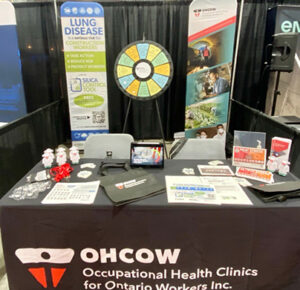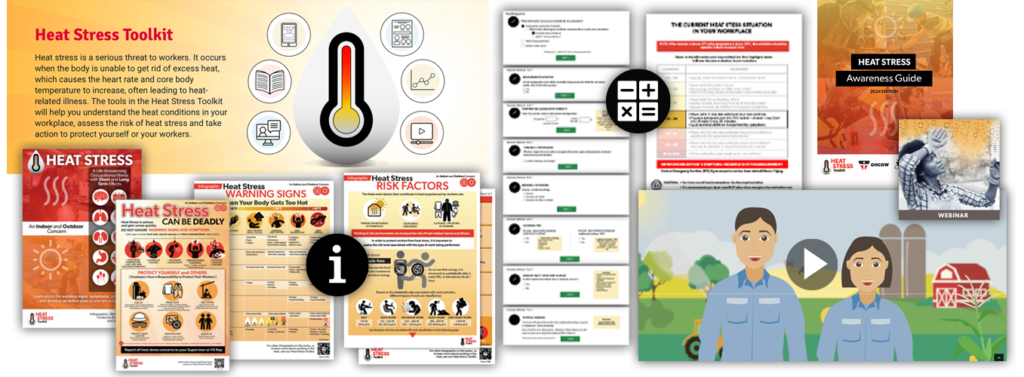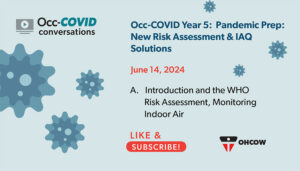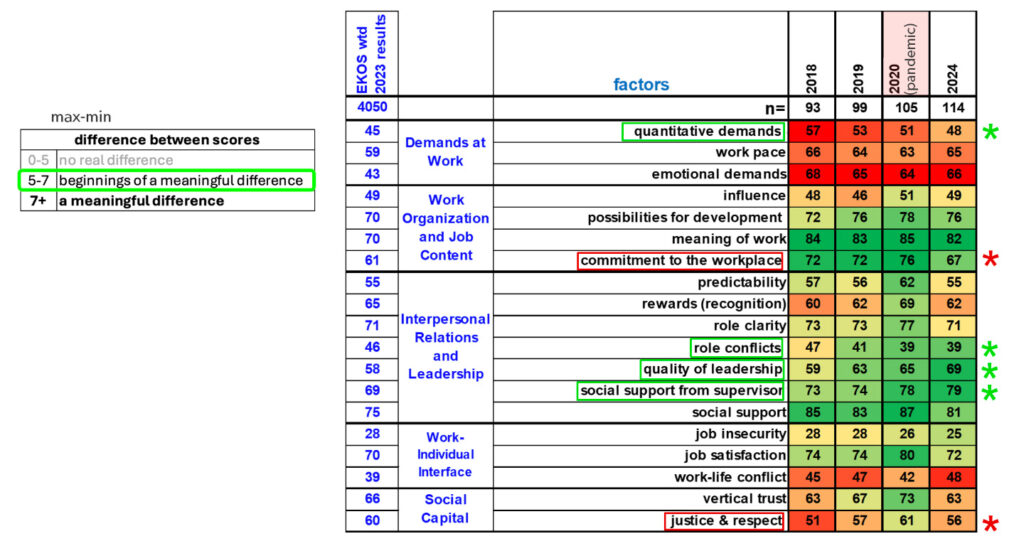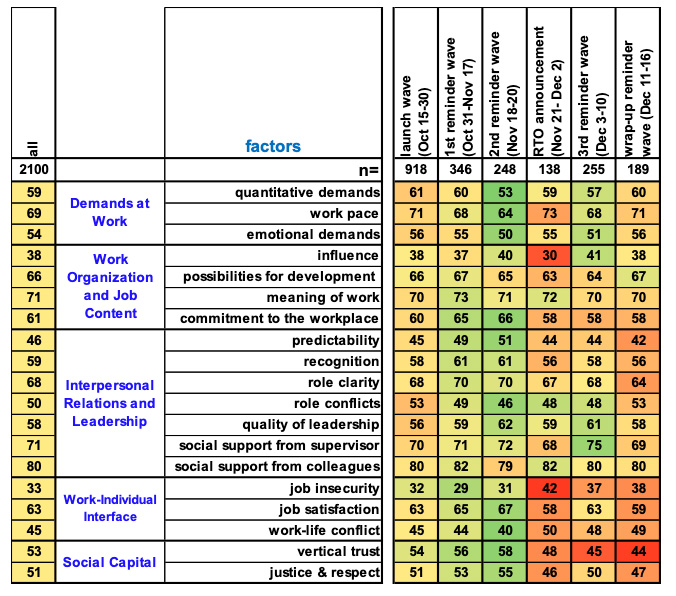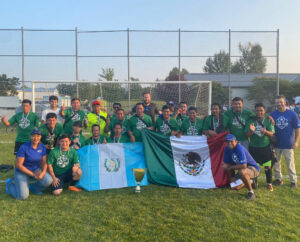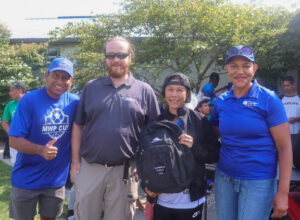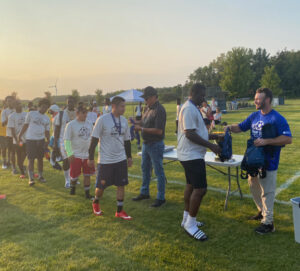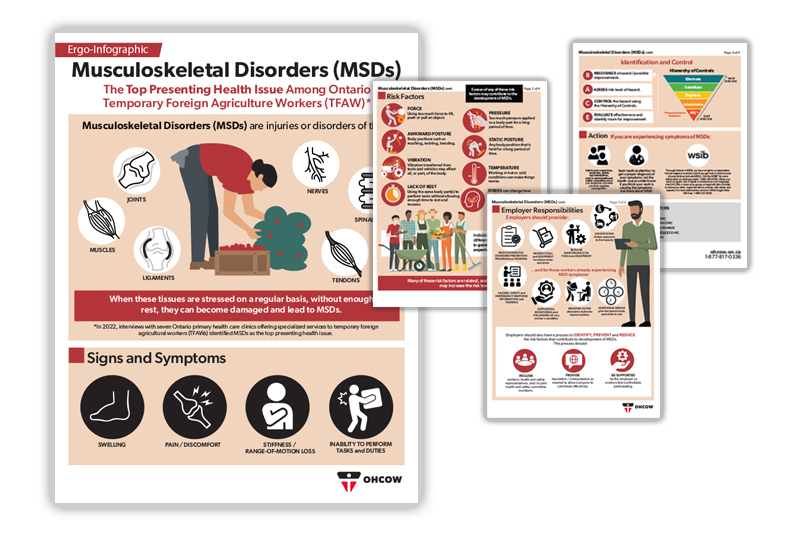- INTRODUCTION
- CASE STUDIES
- KEY PRIORITIES
- TOOLS AND RESOURCES
- FINANCIALS

Annual Report 2024/25

HIGHLIGHTS
In the 24/25 year, OHCOW continued with its support for worker groups, safety programs, producing and improving electronic tools for testing and offering learning initiatives, such as:
Heat Stress Toolkit
• the Heat Stress Toolkit was launched in May 2024. It greatly expanded and improved OHCOW's resources for information about identifying, treating and preventing occupatonal heat related illnesses.
Repetitive Strain Injury Day Webinar Series
• the 2025 session of our most popular webinar series saw its biggest audience ever, with 6,244 registrants for all four sessions.
10th Anniversary of the McIntyre Powder Project

Janice Martell
2025 marked the ten year anniversary of the McIntyre Powder Project, started in April 2015 as a centralized place for miners or other workers exposed to aluminum dust to voluntarily register and document health issues. After years of investigation and advocacy work, Janice Hobbs Martell, an Occupational Health Coordinator at OHCOW, was instrumental in WSIB Ontario's decision in January 2022 to recognize Parkinson's as an industrial disease. This year Janice received recognition for her work in helping injured workers and getting compensation to victims and their families. She received the Ontario Medal for Good Citizenship at an awards ceremony on March 10 and a Mining Safety Leadership Medal from the Canadian Institute of Mining (CIM) in May.
Occupational Illness
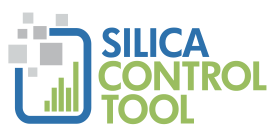
The Campaign
From October 2023 to February 2025 (available stats) the SCT landing page was the site's most visited page outside of the home page, with 34,035 views by 27,938 users. The campaign was started in 2023 to promote use of the free online tool among tradespeople, in particular construction workers who are the most likely to be exposed to silica dust. The strategic use of advertising and "boosted" ads across social media resulted in increased visits to the website overall. Even without the boosted ads, the SCT page views are the highest among OHCOW website pages.
More analytics:
- 958 SCT Account Holders
- 571 Exposure Analysis Dials created (key piece to Exposure Control Plans)
- Silica exposure was reduced by an average of 40%.
- An average of 65% of Admin Controls selected from the tool.
- An average. of 73% of PPE Controls selected from the tool.
- Presented to MLITSD Construction inspectors (6 sessions) and MLITSD Occupational Hygienists (1 session in-person).
- Presented to Members of the Training Provider Network
- Attended and presented at the Provincial Building Trades Conferences, Canadian Concrete Expo in collaboration with BCCSA.
Tradeshow Exhibits
Throughout the year, the SCT team staffed numerous booths, exhibits and trade shows. They are a prime opportunity for our audience to learn about OHCOW, and find out about resources and opportunities to collaborate. In the month of October alone, staff appeared at seven different shows. In February, OHCOW SCT team members participated in one of the biggest national events, the Canadian Concrete Expo, where they spoke to trade show attendees and gave a presentation on February 13 entitled The Silica Control Tool: A free online tool to protect lung health.
OHCOW has numerous promotional materials and hand-outs to distribute to attendees, as well as a vast amount of knowledge about the topic of Occupational Health, making these events highly valuable and productive.
WorldCancerDay 2025 UnitedbyUnique
On February 4, World Cancer Day, the Silica Control Team launched a new campaign “Work to Live. Tool Up for a Healthier Tomorrow." Co-hosted by the Occupational Cancer Research Centre (OCRC), a new webinar that explored the differing cancer risks among male and female workers was featured. Experts discussed the latest findings on cancer risks in the workplace and shared strategies for improving awareness and prevention through knowledge-sharing resources and tools. The goal of the event was how collaboration and innovation can drive real change in protecting workers from occupational cancer.
Work to Live Campaign
By way of a campaign with Evolve Marketing Company, OHCOW released a promotional video, “Work to Live. Tool Up for a Healthier Tomorrow." This video has been promoted through OHCOW social media channels, on the SCT landing page, and in our newsletter. Its recception on social media is among the highest of OHCOW posts. Overall it has received 13 million impressions, with 627,000 targeted impressions and over 308,000 video views, with an 81.21% Video Completion Rate.
Furthermore, an article published with Postmedia in the National Post, entitled Ontario expands access to the Silica Control Tool to protect workers, reached over 83,000 viewers, and a toolbox of digital and print materials for system partners has also been developed.
Podcast
In this podcast, Meghan Friesen and James Miuccio discuss the hazards of crystalline silica exposure in the countertop industry. From the manufacturing of natural and engineered stone, to the finishing and installation processes, they discuss the health risks workers face, such as silicosis and lung cancer.
A Much Needed Resource
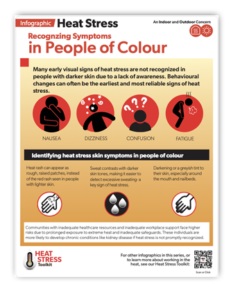 The Heat Stress Toolkit was launched on May 10, 2024. In partnership with the Centre for Research in Occupational Safety and Health (CROSH), it greatly improved and updated OHCOW's resources for identifying, preventing and treating occupational heat stress and related illnesses. Its products are featured in English and French, and Spanish. Heat stress is a huge issue for foreign agricultural workers who labour outdoors in summer months, so the effort is underway to make all our heat stress resources available in languages spoken by these workers.
The Heat Stress Toolkit was launched on May 10, 2024. In partnership with the Centre for Research in Occupational Safety and Health (CROSH), it greatly improved and updated OHCOW's resources for identifying, preventing and treating occupational heat stress and related illnesses. Its products are featured in English and French, and Spanish. Heat stress is a huge issue for foreign agricultural workers who labour outdoors in summer months, so the effort is underway to make all our heat stress resources available in languages spoken by these workers.
The kit includes Youtube videos, a humidex-based heat stress calculator, a humidex-based heat response plan, and three substantial reference guides including the Heat Stress Awareness Guide, the Heat Stress Physiological Monitoring Guide, and the Heat Stress Prevention Tools and Strategies Guide.
Also available in the toolkit are colourful promotional posters suitable for posting in work environments, as well as infographics with information on risk factors, symptoms, warning signs, and other topics. The most recent additions to the Heat Stress resource collection are infographics on Recognizing Symptoms in People of Colour and Heat Stress Sex Based Differences.
Stats
The toolkit has been widely used in the 2024/25 year and has had positive feedback. The Heat Stress Toolkit page was visited 18,837 times by 10, 583 users, with more than 6,640 downloads. The most popular downloads are the Humidex -Based Heat Response plan, the Heat Stress Awareness Guide, Heat Stress Tools and Strategies, the Humidex Poster, and the infographics for Heat Stress Symptoms and Heat Stress Can be Deadly.
Ongoing
The kit will continue to be expanded and improved based on usage and feedback.
Webinar Series: Occupational Illness and Disease Prevention
.
.
.
.
View all these webinars from the Occ|tober and Beyond Video Page.
Week 1: OHS Prevention Works
OHCOW’s annual Occ|tober Webinar Series begins with an overview of the occupational illness prevention activities by the Ministry of Labour, Immigration, Training and Skills Development of Ontario, and Health & Safety System Partners, including OHCOW.
Week 2: What you can’t see can still harm you!
Silica, while safe when used in solid form like in bricks, drywall, countertops, when made airborne, such as by chipping, sanding, or grinding, it can cause fatal lung diseases even when exposures are so low that you can barely see it. Join this session to learn about how the Silica Control Tool is rolling out across Canada and being adapted to other exposures!
Week 3: Can you assess exposures you can’t measure?
Occupational hygienists are experts at measuring exposures and interpreting risk based on exposure limits. But what do we do when we can’t make a measurement, or the chemical doesn’t have an exposure limit? Learn in this session how exposure control banding is a rapidly evolving semi-quantitative process to recognize and control the risk of hazards when measurements and limits are not available.
Week 4: How can your respirator stop things smaller than the filter?
Last updated in 2018 and reaffirmed in 2023, the CSA Standard CAN/CSA Z94.4 (Selection, Use, and Care of Respirators) was amended to include a new section on respiratory protection against bio-aerosols. This addition includes a risk assessment for bio-aerosol protection using respirators. Learn how to assess the hazards of bio-aerosols and select the appropriate respiratory protection.
Week 5: Can we prevent what we can’t see?
Occupational illnesses are conditions that usually require continued exposures over time to develop. Learn how Ontario’s Health and Safety System is helping to identify hazards and implement effective control measures to prevent occupational diseases.
Webinar Series: COVID
Health|care Impact, Lessons & 2024 Work|place Choices
.
.
.
.
Occ-COVID Year 5: Pandemic prep - New Risk Assessment & IAQ Solutions
Layered prevention strategies in public congregate settings, using tools to assess risk, monitor & clean air, are critical for future health. The World Health Organization (WHO) recently released the Airborne Risk Indoor Assessment Tool (ARIA) and stated in the supporting publication " One of the learnings from this pandemic has been that we must reshape and redesign the building environment, while focusing on optimizing indoor ventilation and therefore, the air we breathe" (WHO 2024). The webinar was hosted by Kevin Hedges CIH, COH and featured popular speaker engineer Joey Fox.
Workplace Mental Health
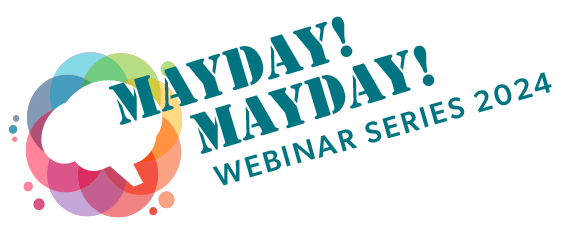
Activating Knowledge for Workplace Mental Health
2024 Workplace Mental Health Webinar Series
View all 2024 webinars from the Mayday, Mayday Page.
Week 1: Marking International Workers' Day + important anniversaries; Sharing history, research & practice; Finding effective, sustainable solutions
A. Making a Difference: Knowledge Activism on a Community Scale
B. Knowledge Activism Research and Implications for Workplace Mental Health
C. Research into Practice: Applied Knowledge Activism and Tool Development
Week 2: International COPSOQ Survey Network Research Stories
May 8, 2024: Copenhagen Psychosocial Questionnaire users share valuable insights and experience in identifying workplace stress factors around the world == Offering insights of interest to all those striving to improve health and well-being in their research or practice. Hosted by members of the COPSOQ International Network
A. (New Zealand): Co-creation or adaptation: COPSOQ to fit the needs of the commercial fishing sector of NZ.
B. (Russia) "Online Data Collection: Validating the COPSOQ Questionnaire"
C. (Belgium) Organizational level health based cut-off points for psychosocial work environment factors
D. (Türkiye) Association between psychosocial risks and eating quality and physical activity
Week 3: Activating Knowledge: WMH Research Initiatives
A. Evidence-Informed Workplace Policies & Practices for PTSI Disability Prevention
B. Understanding Work-Related Suicide
C. NOWW IS THE TIME: Northwestern Ontario Workplace & Worker Health Cohort Study (NOWWHS)
Week 4: Considering Key Issues: Violence, Pain & Surveys
Violence & Harassment + Opioid Harm are key workplace issues and therefore targets of Ontario's Prevention Works Program + Survey success
A. Workplace Violence Risk Assessments – New and Improved Tools
B. Pain/Management role in Opioid Harm Reduction Program
C. How important is it to use a “valid” questionnaire to measure workplace stress?
Week 5: Activating Knowledge: Tools & Services
A. Building new, innovative and practical solutions for workers and workplaces is a key goal of the Ontario Prevention System. Learn & begin!
B. A new tool to assess Workplace Violence in the Education Sector
C. JobAssess - accurately and efficiently capture the 4 critical domains of any job.

Using StressAssess, OHCOW helped a social services office analyze the results of four annual online surveys
Background
OHCOW developed and supports the StressAssess Workplace Survey which is based on the internationally recognized and validated Copenhagen Psychosocial Questionnaire (COPSOQ). It can be used independently via the website, or individually customized by OHCOW Workplace Mental Health (WMH) staff. In the summer of 2024, a unique opportunity arose. A medium sized social services office used an online web-app to self-administer 4 surveys for the years 2018, 2019, 2020 and 2024 and then approached OHCOW for further analysis and comparison over time.
Intervention:
- OHCOW Workplace MentalHealth (WMH) staff aggregated the data from all 4 surveys and looked for definable trends, particularly improvements. For the most recent survey, we also evaluated the changes in average scores for the COPSOQ scales.
- The 2020 survey was done in November while staff were working remotely. For the most recent survey (2024) staff are working at the office workstations again.
- Over the six years, significant improvements were seen for quantitative demands, role conflicts, quality of leadership, social support from supervisor, and bullying.
- The 2020 pandemic lockdown survey results showed improvements in job satisfaction, justice & respect, vertical trust, role conflicts, recognition, commitment to the workplace, and possibilities for development.
- Interestingly, the improvements experienced during the pandemic lockdown disappeared in the 2024 survey (except for role conflicts).
- The trend for bullying mirrored the trend in our Canadian reference population surveys (2016, 2019 & 2023) and thus may not have been due changes at the local level but rather due to changes in attitudes to behaviours considered bullying.
Conclusion
StressAssess in its free and accessible format is an ideal tool to assist organizations in their workplace mental health and injury prevention efforts, especially with the additional support (where needed) by our experienced WMH staff. For this workplace, the StressAssess/COPSOQ survey was able to capture the positive changes during the pandemic lockdown, while also demonstrating that these gains were mostly lost by the time of the 2024 survey. Hopefully these positive and negative changes will allow the workplace parties to identify and pursue lasting improvements over time. We look forward to working with them further in their continued use of StressAssess to monitor the results of their efforts.
Chart: Comparison between surveys (2018-2024)

OHCOW had the opportunity to observe the impact on workplace mental health when remote workers are brought back to the office.
Background
OHCOW developed and supports the StressAssess Workplace Survey which is based on the Copenhagen Psychosocial Questionnaire (COPSOQ), and can be used independently via the website, or individually customized by OHCOW Workplace Mental Health (WMH) staff. In the summer of 2024, a unique opportunity arose to see real-time validated effects of a major change in workplace policy — forcing workers back to the office after working from home, which continues to be a highly contentious issue in Canada.
Intervention
During a large union sponsored survey (almost 3000 members) the employer made an announcement that workers would be required to come to the workplace to do their work after having worked remotely for 4½ years. This particular announcement allowed OHCOW WMH staff to capture the impact of this issue, by comparing the scale scores before and after the announcement.
Prior to the announcement just over 1500 completed responses were received over 3 waves (survey launch, 1st reminder, and 2 reminder). After the announcement, a further 350 completed responses were received.
The COPSOQ scales which were most affected were: job insecurity, vertical trust and work-life conflict. Of equal interest, the scales not affected included: meaning of work, social support from supervisor, self-rated health and symptoms (burnout, sleep troubles, somatic and cognitive symptoms).
This survey also included the GAD-2 anxiety symptom screening questions, and the proportion of respondents screening positive for anxiety was significantly elevated compared to the previous waves. Over 90% of the comments received at the end of the questionnaire after the announcement, referred to this change in a negative context.
Conclusion
- The announcement of the return to office during our survey represented an opportunity for a “natural experiment”
- For this workplace at least (probably generalizable to others) the forced return to office had detrimental impact on some key psychosocial factors (as measured by COPSOQ)
- The StressAssess/COPSOQ survey tool was able to demonstrate the real-time impact of major policy change in an empirical way
Cluster Projects
OHCOW continues to work on claims for this cluster with high rates of cancer, even though the claims were rejected in 2008.
Background
Algoma Steel, (formally Essar Steel) was founded in 1902. It is the largest employer in Sault Ste Marie and the second largest Steel producer in Canada. The company currently employees more than 2,700 unionized workers of United Steel Workers Local 2251 (USW Local 2251) and United Steelworkers Local 2724 (USW Local 2724). Their products are used in automotive, construction, energy, manufacturing, tube and steel distribution industries.
In May of 2008, USW Local 2251 held a 2-day Occupational Disease intake clinic in collaboration with OHCOW. The union was approached by workers and their families, after workers were diagnosed with various Occupational illnesses. At the time of the intake clinic, Sault Ste Marie had four times the provincial cancer rate, according to the Algoma and District Health Unit and the Workplace Safety and Insurance Board (WSIB) statistics. USW Local 2251 members accounted for 3% of the provincial Occupational Disease fatalities registered with WSIB.
540 USW Local 2251 members and their families attended the intake clinic on May 7th and 8th. After the clinic, they held five additional mini-intake sessions surveying an additional 193 workers. As a result, 1,165 claims were filed by USW Local 2251, 261 claims were allowed and 596 were denied. These denied claims were continued to be worked on by USW Local 2251, and files continued to be referred to OHCOW.
In 2022, USW Local 2251 and USW Local 2724 asked OHCOW to reopen the cluster investigation project. OHCOW then established an interdisciplinary team to review the previously denied and abandoned claims. Letters were sent to all past clients and workers who attended the intake clinic in 2008 re-offering services. The OHCOW team commenced consent calls, requested WSIB claims, reviewed the WSIB claim files and moved the files through interdisciplinary consult meetings. The claims were reviewed to see if literature and/or law and legislation has changed, and if these previously denied claims can now be supported.
The risk factors for cancer and other illnesses are multifactorial. For the patient to be entitled to benefits, a causal relationship between the occupational exposure and the diagnosis must be demonstrated. Lung Cancer and Chronic Obstructive Pulmonary Disease (COPD) is the most predominant illness to come out of the Algoma Steel Cluster investigation project. Workplace exposures of asbestos, silica, coke oven emissions, respirable dusts etc. continue to be reviewed by our hygienists.
This is an ongoing project. At this time our Algoma Cluster investigation team continues to work through files that have been reopened as well as newly referred files.
What’s coming next?
- In 2025-2026, we will continue to contact workers or their next-of-kin through follow-up phone calls and letters to update their information and determine what further support can be provided.
- As part of our ongoing work, we will continue to obtain, compile, and review medical records and work histories of individual clients, and we will develop individual reports regarding the contribution of work exposures to health issues.
- Supporting workers through the WSIB GI Cancer Policy Change
In response to the recent policy change at the Workplace Safety and Insurance Board (WSIB) regarding gastrointestinal (GI) cancer claims, OHCOW has taken proactive steps to support affected workers and advocates. Recognizing the significance of this change, we have activated a dedicated team to review previously denied claims and assess them under the new policy framework. Through this work, OHCOW is working closely with workers, their families, and advocates to ensure that previously denied files are reconsidered.
Investigating a Mini-Cluster of Brain Cancer Cases
A group of brain cancer cases have been identified within the larger occupational disease cluster. OHCOW has established a dedicated team to investigate these files. Our experts are conducting in-depth assessments to determine potential occupational exposures.
We want to hear from you!
- Did you or your family member work at Algoma Steel?
- Do you have concerns about the impact of your work on your health?
- Contact The Occupational Health Clinics for Ontario Workers (OHCOW) at 1-613-218-7345 or email jmontgomery@ohcow.on.ca
- for further information or to register with us as part of our Algoma Steel cluster investigation
Conversations with miners and their families are ongoing, and project updates have been mailed out. Presentations on McIntyre Powder have been made in educational institutions and unions.
Background
McIntyre Powder (finely ground aluminum dust) was administered to mine workers in Ontario in most gold and uranium mines between 1943 and 1979, under the mistaken belief that it would prevent the lung disease silicosis. Since 2016, OHCOW has been actively investigating the health issues linked to McIntyre Powder and multiple other mining exposures experienced by Ontario mine workers, such as diesel engine exhaust, respirable crystalline silica, lubricants, ionizing radiation, arsenic, solvents, dusts, fumes, and more.
What did we accomplish this year?
- Conducting intensive follow-up outreach to workers and their families
- In addition to the significant number of incoming calls and inquiries we receive almost daily from workers or their surviving family members, we prioritized actively following up with our McIntyre Powder-exposed mine workers to gather updates on their health status, contact information, WSIB claim outcomes, and more. - Initiating 479 phone calls and sent 490 letters to workers or their next-of-kin, including 375 follow-up outreach calls and 104 follow-up letters to document updates and provide further services as needed.
- Mailing project update newsletters to 509 workers and their families.
- Supporting workers and their families to navigate the WSIB claims process, including assisting with the initial paperwork to file claims for 35 workers for 42 health conditions. We continue to link workers with worker representative services for WSIB claims.
- Raising awareness through our annual newsletter, media engagement, and email outreach to MP mine workers and their next-of-kin regarding the findings of a new study published in American Journal of Industrial Medicine that links McIntyre Powder exposure to increased risk of specific types of cardiovascular disease (heart attacks, ischemic heart disease, and congestive heart failure). We began the process of assisting affected workers or their next-of-kin to commence new occupational disease claims for cardiovascular disease, as a result of this study.
- Registering 14 new McIntyre Powder-exposed mine workers for our services.
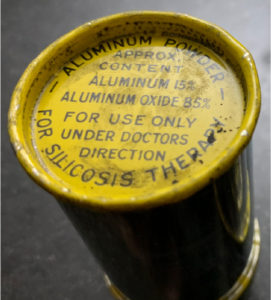 We conducted multidisciplinary reviews of individual worker files and provided individualized reports to support workers’ compensation claims.
We conducted multidisciplinary reviews of individual worker files and provided individualized reports to support workers’ compensation claims.
- Our Physician-led multidisciplinary team reviewed the medical and work history records for 52 workers to assess for any work-related health issues and determine the next steps.
- We provided our MP mine workers (or their legal next-of-kin) with 21 individual medical and 17 occupational hygiene reports addressing their specific work exposures and health issues. These reports supported the pursuit of individual WSIB claims, and reconsideration of denied claims.
We conducted educational presentations to the next generation of labour leaders and occupational hygienists.
- Presentations on McIntyre Powder history and our work with the McIntyre Powder cluster were provided through our community partner, the McIntyre Powder Project, to Labour Advocacy students at Laurentian University, Occupational Hygiene senior students at the University of Toronto, and labour leaders at the USW Justice 2024 conference.
What’s coming next?
- We will continue to support workers to complete the initial paperwork to start workers’ compensation (WSIB) claims for health conditions related to their mining exposures, and to link them with services from the Office of the Worker Adviser to represent them on claims and appeals.
- We will continue our ongoing work to gather, compile, and review individual client medical and work history records, and to provide individual reports to workers regarding the contribution of their work exposures to the development of their health issues. This will include a specific focus on cardiovascular disease, given the recent study findings.
We want to hear from you!
- Did you or your family member work in Ontario mines that used McIntyre Powder?
- Do you have concerns about the impact of your work on your health?
- Contact OHCOW at 1-800-461-7120 for further information or to register with us as part of our group of McIntyre Powder-exposed mine workers.
The Project
In 1981, a German plastic auto parts firm came to Canada and first located in a 22,000 square foot facility in Kitchener, Ontario. Initially, automobile parts were made in Germany, then, were shipped to Kitchener for completion, and finally routed to General Motors in the United States. In 1984, a new production line was developed using a process called “post‐lamination” for making auto side molding with coated stainless steel sheet metal.
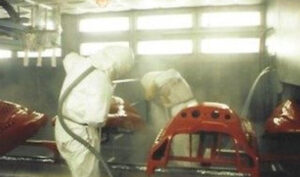
Employees at work. Source.
By 1986, parts were manufactured at the Kitchener plant using an innovative process, “reaction injection molding,” brought from Germany and called “R‐RIM”. With production expanding, the company set up a second facility in Peterborough, purchasing a 200,000 sq. ft. metal clad structure, which was expanded in the late 1990s to accommodate its larger thermoplastic injection molding machines and production operations. The current plant is well over 350,000 square feet. Over a decade (1986 to 1996), the Ventra Plastics workforce grew from 75 to 575 women and men, with production increasing from one product to 30 different products. Initially when most jobs involved close “hand work”, the workforce included more women than men (60:40), becoming closer to 50:50 as operations became more automated.
The Occupational Health Clinics for Ontario Workers (OHCOW) has been actively engaged in with the Ventra Plastics workers since 2004, working very closely with Unifor Local 1987. Many different illnesses have been reported, including but not limited to:
Cancer
- Lung
- Salivary Gland
- Breast
- Prostate

Ventra/Pebra worker obituaries compiled by Rose Wickman and Jackie Dufty (Unifor Local 1987) to mark and honor lives lost.
Among others (e.g., pancreatic, colon, GI)
- Chronic Toxic Encephalopathy (CTE) - brain injury
- Female Reproductive Issues
- Respiratory Outcomes (e.g. COPD)
- Cardiovascular disease
- Asthma
- Headaches and Migraines
- Musculoskeletal Issues
In 2025, Ventra Plastics workers face new challenges and stressors, including job loss, due to the implementation of automotive industry tariffs by the United States’ Trump administration.
What did we accomplish this year?
- Mailing project update newsletters to workers and their families.
- Continuing to conduct health and exposure interviews with workers and their families.
- Conducting reproductive health questionnaires with workers who have expressed concerns about their reproductive health and potential connections to work tasks.
- Supporting workers and their families in navigating the WSIB claims process, including assisting with the initial paperwork to file claims, completing the Workplace Safety and Insurance Board Intent to Object Form (ITO) and actively collaborating with Unifor Local 1987 and The Office of The Worker Advisor (OWA).
- Hosting a virtual information session to register new workers, to discuss key diagnoses and exposures within the plant, to share information about reproductive health, and to support workers in understanding the worker’s compensation process. The recording of this virtual session is here.
What’s coming next?
OHCOW and Unifor Local 1987 will host another in-person session on June 24, 2025
- Continuing worker outreach in 2025-2026 by conducting follow-up calls and sending update letters to workers and their family members. These follow-up efforts will allow us to obtain any updates to health information and assess how we can offer additional support.
- Continuing our ongoing work in the collection, compilation, and examination of the individual client files, medical and work and exposure history. We will further review client files and provide reports detailing the correlation between the workers work and exposure and the onset health issues.
- Continuing to work with our Interdisciplinary team to review files and provide reports to the workers or estates legal representatives to submit to The Workplace Safety and Insurance Board (WSIB) on their behalf.
- Planning to host an information session focused on reproductive health concerns, including creation of a resource outlining key exposures of concern (e.g. chemical, physical, emotional) as well as recommendations related to task modifications that could improve safety. An occupational health physician and/or nurse will be present for this session.
We want to hear from you!
- Did you or your family member work at Pebra/Ventra Plastics?
- Do you have concerns about the impact of your work on your health?
Please Contact our Occupational Health Coordinator, Jessica Montgomery at 1-613-218-7345 for further information or to register with us as part of our group of Ventra Plastics Project.
For workers with reproductive health concerns:
We are investigating potential linkages to workplace duties or hazards.
In 2014 OHCOW saw 15 patients with a variety of nasal and respiratory symptoms from the Kellog's plant in London, Ontario. Three workers had been exposed to carbon monoxide. 20 patients from this factory are currently being seen by OHCOW.
What did we accomplish this year?
We secured WSIB advocacy and began patient work.
- Advocacy was secured with an Office of the Worker Advisor (OWA) team.
- A Kelloggs Intro meeting brought others up to date with documents and work completed so far on this project.
- Approximately six workers were contacted, and each reported multiple issues.
- Our new system with OWA initiated compensation claims for those workers that have been called. Currently we are awaiting the status of those WSIB claims.
What’s coming next?
An OHCOW/OWA meeting is planned to allow both organizations to develop common ground with our processes. Freedom of Information Requests with WSIB, MLTSD and MOE are moving forward, and OHCOW will be conducting more worker outreach in 2025/6. This outreach will include letters to workers or their next-of-kin, to update their information and take histories to identify occupational diseases from their other work experience. Once the WSIB claims of the 20 workers are received, we will meet to review the outcomes, update our CHR with cases, and identify common denied diseases for physician and hygiene work ups. Also in the works:
- Finishing reports on the current twenty patients, with referrals to the OWA.
- Gathering, compiling, and reviewing current WSIB claims and those that have been submitted in the past.
- An active Kellogg's Facebook page (with 70 followers) will be used for outreach, with postings and information. We will monitor the response from that posting.
- Arranging for medical and industrial hygiene assessments to provided individual reports for workers and their workers compensation (WSIB) claims for health conditions related to their work exposures. These claims will be case managed by Occupational Health Nurses.
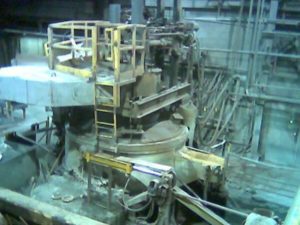 The Neelon Casting project is an investigation into the occupational exposures and working conditions at a Steel foundry in Sudbury Ontario specializing in brake parts manufacturing. Established in 1975 under the name Neelon Steel, the facility underwent ownership changes to become Dana brake parts, and eventually Affinia Canada Corp. In 2007, the plant, which employed 240 workers at the time, closed.
The Neelon Casting project is an investigation into the occupational exposures and working conditions at a Steel foundry in Sudbury Ontario specializing in brake parts manufacturing. Established in 1975 under the name Neelon Steel, the facility underwent ownership changes to become Dana brake parts, and eventually Affinia Canada Corp. In 2007, the plant, which employed 240 workers at the time, closed.
Throughout the 32 years of the Foundry’s operation, over 2,000 unionized workers were employed there. Since the inception of this project, more than 500 of these former workers and family members have reached out to the United Steelworkers, Local 2020 to share and document their experiences working at the plant.
Since 2020, OHCOW has been actively engaged investigating the health concerns reported by the Neelon Casting workers and their families. The connections between the working conditions, chemical exposures, and the prevailing health issues noted among the former employees are being investigated.
What did we accomplish this year?
- Continuing to conduct work and exposure interviews with workers and their families.
- Supporting workers and their families to navigate the WSIB claims process, including assisting with the initial paperwork to file claims, and working with The United Steelworkers, Local 2020.
- Our Occupational hygienists created a data base to store all the Ministry of Labour documentation that was previously requested through Freedom of Information requests.
- Our occupational physicians have reviewed all the Neelon Casting files that have been denied due to medical and if they were able to support the claim have provided written reports to the worker representatives to support to The Workplace Safety and Insurance Board.
Supporting Workers Through the WSIB GI Cancer Policy Change:
In response to the recent Workplace Safety and Insurance Board (WSIB) policy change regarding gastrointestinal (GI) cancer claims, and asbestos exposure, OHCOW has taken proactive measures to support affected Neelon workers and their families. Recognizing the impact of this policy update, we established a dedicated working group comprising an Occupational Hygienist, an Occupational Health Coordinator, and a Legal Representative to provide expertise and guidance in navigating this updated framework in policy 16-02-11 (October 1, 2024). Our primary focus is to review previously denied Neelon GI cancer claims and assess them within the framework of the updated policy. This involves conducting detailed re-examinations of the worker’s work and exposure histories to determine if the claim meet the revised asbestos exposure criteria. By leveraging our expertise in occupational hygiene and legal lens, we are ensuring that each case is thoroughly reviewed.
What’s coming next?
- Plans to conduct extensive worker outreach in 2025-20256 through follow-up phone calls and letters to workers or their next-of-kin, to update your information and determine what further supports we can provide to the Neelon Casting Workers and their families.
- Continuing to support workers to complete the initial paperwork to initiate Workplace Safety and Insurance Board claims (WSIB) for health conditions related to their exposures at the Neelon Casting Foundry, and to link them with services from The United Steelworkers (USW) Local 2020 or The Office of The Worker Advisor (OWA)
- Continuing our ongoing work in the collection, compilation, and examination of the individual client files, medical and work and exposure history. We will further review client files and provide reports detailing the correlation between the workers work and exposure and the onset health issues.
We want to hear from you!
- Did you or your family member work at Neelon Casting, Dana Brake Parts of Affina Canada Corp?
- Do you have concerns about the impact of your work on your health?
- Please Contact our Occupational Health Coordinator, Jessica Montgomery at 1-613-218-7345 for further information or to register with us as part of our group of the Neelon Casting project.
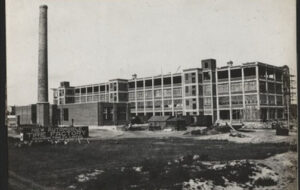
Historic photo of the Dominion Tire Factory in Kitchener, Ontario.
The Rubber Worker Project is one of OHCOW’s most long-standing projects. Research has shown that there are links between certain rubber industry exposures and health impacts experienced by workers, including cancer outcomes. In this project, we aim to review and conduct research on potential connections between rubber work and health as well as share our learnings with rubber workers and their families to help: (1) prevent or reduce harmful exposures at work, (2) synthesize medical and hygiene evidence for worker’s compensation claims, and (3) identify areas for further research.
What did we accomplish this year?
We continue to update our rubber worker client database to prepare for further case support.
- Our rubber worker project database allows us to investigate emerging links between certain workplace exposures and health outcomes.
- This year, we have used the database to better understand how cases are proceeding through the workers compensation system.
- For example, 15 case decisions have been overturned at WSIAT, whereas 18 additional cases are currently under appeal.
We are reviewing groups of cases organized by common diagnoses and exposures to identify known and emerging patterns.
- We supported 36 workers and/or their families with new or existing WSIB occupational disease claims.
- We conducted in-depth reviews of 21 occupational disease cases with our interdisciplinary team (physicians, nurses, hygienists, etc.)
- We held a case conference with the Office of the Worker Advisor to provide updates and outline next steps for each shared occupational disease file to ensure we can keep them moving forward in a timely manner.
- This year, we have expanded our targeted case reviews to include GI cancers, including stomach, esophageal, and colorectal cancer.
- We will continue to review primary outcomes of concern raised by rubber workers and their families (e.g. bladder and lung cancer, non-Hodgkin’s lymphoma, COPD, etc.)
We are preparing educational materials for workers.
Salivary gland cancer
- Salivary gland cancer is a rare cancer of the salivary glands, which are the glands that produce saliva in your mouth. Multiple rubber workers in our cohort have been diagnosed with this illness.
- We finalized a systematic literature review on existing connections between salivary gland cancer and occupational/environmental exposures in 2024 (submitted for publication Spring 2025).
Rubber industry hazards resource
- Our hygiene team has worked to create a document summarizing key rubber industry hazards. To-date, we have included information on N-nitrosamines, carbon black, and toluene, with plans to expand.
We hosted a focus group with rubber worker retirees (SOAR) to learn more about exposures.
- We met with a group of rubber retirees to (1) provide updates on the status of OHCOW medical cases, (2) learn more about plants that are currently active in Canada (to support us in sharing our lessons-learned with active workers), and (3) to gain feedback on the format, location, and timing of our next in-person information session planned for 2025-26.
What’s coming next?
- We plan to update our website with new educational materials for workers and their families.
- We will continue to expand worker outreach in 2025-2026, including to active rubber workers.
- We are planning a public information session in summer/fall 2025 to share our findings to date.
- We will continue to support workers with exposure prevention and worker compensation matters.
We want to hear from you!
- Have you and/or your family members worked in the rubber industry?
- Do you have concerns about the impact of your work on your health?
- Contact OHCOW anytime for a medical or exposure prevention consultation at rw@ohcow.on.ca.
 Our team continues to gather and review available medical and work history records for individual GE clients. We also research and review available evidence from scientific studies and clinical literature of health conditions that have links to past workplace exposures at GE Peterborough.
Our team continues to gather and review available medical and work history records for individual GE clients. We also research and review available evidence from scientific studies and clinical literature of health conditions that have links to past workplace exposures at GE Peterborough.
What did we accomplish this year?
- We completed medical and occupational hygiene reports for lung cancer, liver cancer and prostate cancer cases.
- We created various exposure assessment tools and occupational hygiene (OH) assessment templates, that allowed us to assess multiple cases with the same diagnosis.
- Occupational hygiene exposure report templates, for each of the diagnosis examined this year were created, utilizing standardized text and a review of all relevant occupational exposures related to the diagnosis. This approach allowed for timely, concise, and consistent exposure assessments of similar types of denied claims.
What’s coming next?
A Freedom of information (FOI) request was submitted to obtain occupational health and safety records for General Electric Trenton. OHCOW has received this documentation, and the GE project hygiene team is currently assessing this information.
- Continued interdisciplinary teamwork with Prostate Cancer (Reproductive System) claims
- Interdisciplinary team focus on Pancreatic Cancer and Respiratory disease processes
- Review and recognition of files that can be revisited by WSIB due to policy changes and updates
- Continued review and interdisciplinary team work on files from a body systematic perspective
- Continued efforts to communicate with workers, worker advocates, families and interested stake holders by OHCOW reach out and town halls
- The March GE Project community partners meeting will be scheduled later this year
We want to hear from you!
- Did you or your family member work at General Electric in Peterborough?
- Do you have concerns about the impact of your work on your health?
- Contact OHCOW for further information or to register with us as part of our GE Peterborough worker cohort.
The Dryden Weyerhaeuser Recovery Boiler #4 (RB4) Project focuses on a retrospective assessment of health risks and exposure profiles for approximately 400 tradespeople who may have been exposed to un-scrubbed stack emissions during project work between 2002 and 2004.
Since 2004, OHCOW has been actively investigating health concerns reported by these workers, which are believed to be linked to those exposures.
What did we accomplish this year?
- Sentinel Case Development: Several worker cases have been selected for detailed exposure profiling. Background records and chemical emission data have been compiled to support Retrospective Exposure Reviews (RERs).
- Chemical Exposure Analysis: The emissions involved a complex mix of chemicals. Understanding their composition and exposure levels is essential to evaluating links to illnesses such as Chronic Toxic Encephalopathy (CTE).
- Health History Interviews: OHCOW has begun conducting nursing health history interviews with RB4 workers to identify new diagnoses and assist with WSIB claim initiation.
What’s Coming Next?
- Literature Review: Conduct an updated review of scientific literature on the health impacts of paper mill emissions, with a focus on CTE.
- Complete Sentinel Case Work: Finalizing these cases may encourage more workers to come forward and support others in filing similar claims.
- Community Engagement:
- -Continue participating in committee and town hall meetings.
- -Plan and host an in-person town hall to reach more affected workers.
- Ongoing Support:
- -Assist workers with navigating the WSIB claims process.
- -Open new files for any additional workers and add them to the active worker list.
We want to hear from you!
If any of the following apply to you or a family member, please reach out:
- Worked on the RB4 project between 2002–2004?
- Need help opening a WSIB claim?
- Need guidance on appealing a denied claim?
- Experiencing neurological or other health issues potentially linked to workplace exposures?
Contact OHCOW at 519-337-4627
Or complete the questionnaire at: https://www.ohcow.on.ca/occupational-illness/occupational-disease-cluster-investigations/dryden-weyerhaeuser

Testimonials
OHCOW has been very helpful with their knowledgeable staff. Having a second opinion from the medical staff onboard their team has helped our workers with occupational diseases. Claims that were denied are being allowed once WSIB reconsiders OHCOWs report.
We heavily rely on OHCOW's reports to help get denied WSIB decisions overturned. They are an important component in helping us get compensation to injured workers.
OHCOW's service is needed to provide professional information to unions and industries in order to prevent injuries and occupational exposures to workers. Their services has helped immensely to families that suffered injuries.
Injury Prevention

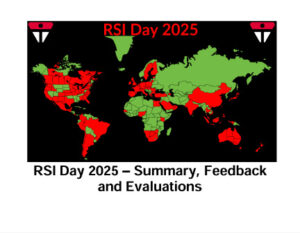 2025 marked the 26th anniversary of RSI Day educational sessions organized by the Occupational Health Clinics for Ontario Workers (OHCOW). Since 2021, the RSI Day event has transitioned from a full-day program to a four-week, 2-hour webinar series held throughout February. Each week focused on a different theme, covering a range of topics related to ergonomics and musculoskeletal disorders.
2025 marked the 26th anniversary of RSI Day educational sessions organized by the Occupational Health Clinics for Ontario Workers (OHCOW). Since 2021, the RSI Day event has transitioned from a full-day program to a four-week, 2-hour webinar series held throughout February. Each week focused on a different theme, covering a range of topics related to ergonomics and musculoskeletal disorders.
In total there were 6,244 registrants, and 71% of that number registered for all four sessions. People registered from around the world, including India, Malaysia, U.K., Australia, and more. A full account of the stats of the RSI Day webinars is available.
View webinars from the 2025 RSI Day Webinar Page
Week 1: Clinical Insights & Applying New Technology
Osteoarthritis of the Carpometacarpal Joint (Thumb)
Osteoarthritis of the Hip
Implementing Markerless Motion Capture Technology for Ergonomics Assessments
Week 2: Reality Check 2025 - Hazard Mitigation
Week 4: Key topics in Occupational Ergonomics 2
Visual Ergonomics: The Relationship Between Vision and Office Ergonomics
Review of the Quick Exposure Check (QEC) Reference Guide
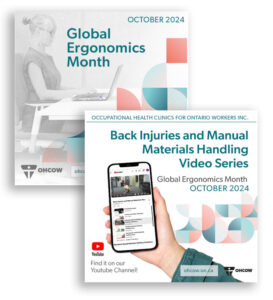 Back Injuries and Materials Handling Video Series
Back Injuries and Materials Handling Video Series
This series of eight videos was produced during Global Ergonomics Month 2024 in recognition of the MLITSD Industrial Sector Compliance Initiative on Material Handling. This year-long enforcement campaign asks inspectors to visit various sectors where fatalities and critical injuries are taking place. The focus is on workplaces where materials, articles or things are lifted, carried, or moved, and puts workers at risk of being injured by their movement.
For information on the updated Apps and Tools in the Injury Prevention Category, see the Tools and Resources section here.
Marking International Workers' Day + important anniversaries; Sharing history, research & practice; Finding effective, sustainable solutions
Wednesday, May 1, 2024
May Day is celebrated as Labour Day around the world, and it was also the 1989 start date of OHCOW's first Occupational Hygienist, John Oudyk. This year we'll celebrate OHCOW (and John’s) 35th anniversary through the cross-sectional lens of Knowledge Activism and Workplace Mental Health and Injury Prevention, which we continue to champion.
Making a Difference: Knowledge Activism on a Community Scale
Learn about past and recent contributions of the United Steelworkers Union - all pivotal steps of worker knowledge mobilizing prevention progress, beginning with the Elliott Lake Wildcat strike 50 years ago, OHCOW's origins in the 80s, translating the Westray Mine Explosion into the Criminal Code in 2004 and facing the mental health and gender-based violence challenges we now recognize in workplaces today.
SPEAKERS: Sylvia Boyce, United Steelworkers Canadian National Office, Health, Safety & Environment Department Leader
Knowledge Activism Research and Implications for Workplace Mental Health
Review important research on worker activist engagement and success and consider the implications in the context of worker (and activist) mental health.
Dr. Alan Hall, Honorary Research Professor, Memorial University
Research into Practice: Applied Knowledge Activism and Tool Development
2024 is also the 15th anniversary of the Mental Injury Tool Group, which pioneered the recognition of stress and other harm-inducing factors as occupational hazards warranting assessment and elimination/control, developing an entire toolkit and fostering knowledge activation with its core element, a validated survey built on the Copenhagen psycho-social Questionnaire.
The MIT/StressAssess story is essentially a case study in applied knowledge activism in the form of tool development which has been a common thread of OHCOW's practice under John's leadership.
SPEAKER: John Oudyk, MSc, CIH, ROH, Occupational Hygienist, OHCOW
For more Workplace Mental Health information and resources visit our Workplace Mental Health page or our StressAssess page.
SEE WEBINARS AND SLIDES
International COPSOQ Survey Network Research Stories
May 8, 2024
Copenhagen Psychosocial Questionnaire users share valuable insights and experience in identifying workplace stress factors around the world == Offering insights of interest to all those striving to improve health and well-being in their research or practice. Hosted by members of the COPSOQ International Network
(New Zealand): Co-creation or adaptation: COPSOQ to fit the needs of the commercial fishing sector of NZ.
Highlighting a pilot project contextualising COPSOQ for the fishing sector, completed last December for Maritime New Zealand . The presentation includes feedback from industry along with findings shared at IFISH 6, along with the methodology of the project.
Speaker: Dr. Fatima Junaid MBA, MSc, PhD, , ANZITT, APA, Senior Lecturer, Doctoral Co-Supervisor School of Management
(Russia) "Online Data Collection: Validating the COPSOQ Questionnaire"
Describing an insightful journey utilizing online services to gather data for the validation of the national version of the COPSOQ questionnaire. The initiative not only streamlined their data collection process but also significantly contributed to the robustness and reliability of their validation efforts.
Speakers: Anna Novikova, PhD, Senior Researcher; Vasiliy Shirokov, Professor , Scientific Head of the Institute of General and Occupational Pathology
(Belgium) Organizational level health based cut-off points for psychosocial work environment factors
Unlike benchmarks, cut-off points are health-based reference values and refer to a relevant health outcome. This enables researchers to distinguish between positive and negative effects on health. Group level cut-off points should be used in an organizational context. From a preventive point of view the use of an early indicator of reduced well-being is indicated. The aim of this study of191 organizations (26558 subjects) was to determine cut-off points on an organizational level based on the prevalence of high need for recovery.
Speaker: Dr. Philippe Kiss, Honorary fellow, Faculty of Medicine and Health Sciences, Department of Public Health and Primary Care
(Türkiye) Association between psychosocial risks and eating quality and physical activity
Cardiovascular Disease (CVD) is a leading cause of mortality worldwide, prompting extensive research. While direct association between psychosocial risk (PSR)/eating habits to CVD has generated significant attention, the interplay between psychosocial risk and eating habits remains relatively unexplored. The current cross sectional study explores the intricate interplay between these two variables while also delving into the relationship between psychosocial risks and physical activity among a sample of 260 medical staff members from Burns and Plastic Surgery Hospital in Tripoli, Libya.
Speakers: Marwa Ali Ahmed Doufani, Yeditepe Univ. Institute of Health Science, MPH programme, Turkiye & Primary Health Care Institute, Libya
Yucel Demiral, Dokuz Eylul Univ. Medical Faculty, Dept. Public Health, Turkiye
SEE WEBINARS AND SLIDES
Activating Knowledge: WMH Research Initiatives
May 15, 2024
Evidence-Informed Workplace Policies & Practices for PTSI Disability Prevention
The prevalence of post-traumatic stress injuries (PTSIs) among first responders is high and often leads to work disability. Recent studies have shown that organizational policies and practices have an important impact; however, the scientific evidence about the effectiveness of interventions is limited. Regardless, first responder organizations must develop ways to protect workers. Learn about this project to engage with Alberta first responder stakeholders to co-develop an evidence summary on current, best and effective interventions to manage and prevent PTSIs, to ensure the findings are relevant, and to increase the uptake of this knowledge in Alberta.
Speakers: Emile Tompa, MBA, PhD, Executive Director, IDEA,Director, CRWDP,Associate Professor, McMaster University,Senior Scientist, Institute for Work & Health; Emma Irvin, Director, Research Operations, Institute for Work & Health
Understanding Work-Related Suicide
Join Dr. Bittle for an update on his research, which includes analysing WCB appeals on work-related suicide and continuing analysis of the 2023 Work-Related Suicide Survey, whose purpose is to examine how to define the phenomenon, its causes and consequences, relevant laws and polices, and current and recommended prevention strategies. The goal is to better understand the nature and scope of work-related suicide and related response and prevention measures.
Speaker: Dr. Steven Bittle, Professor, Department of Criminology, University of Ottawa
NOWW IS THE TIME: Northwestern Ontario Workplace & Worker Health Cohort Study (NOWWHS)
Learn about (and participate in) the largest cohort study ever conducted in Northwestern Ontario which examines workplace factors for health and wellbeing in the workplace. It is being conducted by the EPID@Work (Enhancing the Prevention of Injury and Disability at Work) Research Institute at Lakehead University
Speaker: Dr. Vicki Kristmann, Professor, Lakehead University; ON Research Chair in Injury & Disability Management; Director & Senior Scientist, EPID@Work Research Institute
SEE WEBINARS AND SLIDES
Considering Key Issues: Violence, Pain & Surveys
May 22, 2024
Violence & Harassment + Opioid Harm are key workplace issues and therefore targets of Ontario's Prevention Works Program + Survey success
Workplace Violence Risk Assessments – New and Improved Tools
The MLITSD Prevention Works Committee focusing on work-related mental harms and workplace violence and harassment has decided that a new tool is required to effectively support Ontario workplaces to assess the risk of violence. With a focus on small businesses, WSPS is taking the lead to develop a user-friendly tool that will help meet legislative requirements and decrease harms associated with violence at work. During this interactive session, you will be given the opportunity to share what you would like to see included in this tool and what’s coming down the pipeline.
Speaker: Kristy Cork, CRSP, Specialized Consultant – Healthy Workplaces, Workplace Safety & Prevention Services (WSPS)
Pain/Management role in Opioid Harm Reduction Program
Did you know the WHO recognizes chronic pain as a disease of it’s own? However, many people still believe in the “suck it up” approach, relying upon self-treatment or self-medication, which we know is problematic, -- in particular if illicit drugs like opioids are involved. Chronic pain can be difficult to control and some days can be better than others. Good pain management supports at the workplace help workers manage their situation to not just function at work, but to also avoid the all too common trap of seeking illicit market opioids to “cope”. Learn how opioids, chronic pain and pain management intersect when addressing opioid related harms and workplace accommodations.
Speaker: Kathy Martin, Coordinator, Research, Stakeholder & Public Relations, Mental Health and Wellness Specialist, Infrastructure Health & Safety Association (IHSA)
How important is it to use a “valid” questionnaire to measure workplace stress?
In the HR field there are all kinds of surveys available to workplaces – surveys that claim to measure engagement, job satisfaction, workplace culture, burnout, etc. Very few of authors of these commercially available surveys have published any evidence regarding their validity and reliability of their instruments. There are also disagreements about the need to establish the validity of questionnaires: some saying its “overkill”. What does it mean to use a “valid” questionnaire? This session will review these questions and explore the implications for the use of surveys in the workplace.
Speaker: John Oudyk, MSc, CIH, ROH, Occupational Hygienist, OHCOW
See Videos and Slides
Activating Knowledge: Tools & Services
May 29, 2024
Building new, innovative and practical solutions for workers and workplaces is a key goal of the Ontario Prevention System. Learn & begin!
A new tool to assess job-based risk of psychological harm
Introducing the Occupational Psychological Risk Assessment Tool – a collaborative solution for assessing risk of psychological harm on the job. The OPRA is an innovative, web-based tool that uses a shared, participatory approach to review job factors that impact worker mental health, rate subjective risk of psychological harm, and collectively identify solutions to support worker wellbeing. Participants will:
- Review the mental health continuum and job-based psychological harm
- Learn how job factors can impact worker mental health
- Explore a new tool to assess and control risk of psychological harm on the job
Speaker: Tegan Slot, Manager, Workplace Wellbeing, Public Services Health & Safety Association (PSHSA)
A new tool to assess Workplace Violence in the Education Sector
Introducing the Workplace Violence Risk Assessment (WVRA) Tool for the K-12 Education Sector. The WVRA is an innovative, solution that was created by educators, administrators and OHS professionals for their environment. The tool uses a shared, participatory approach to review job conditions where workers may experience violence, assess the risk, and discuss mitigation strategies that are applicable to their environment. Participants will:
- Learn how the Workplace Violence risk assessment was developed.
- Learn how the WVRA tool is to be utilized.
- Next steps for the WVRA tool to be integrated into the education sector.
Speaker: Chris Arsenault, Director, Health, Safety & Wellbeing, Education and Specialized Services, Public Services Health & Safety Association (PSHSA)
JobAssess - accurately and efficiently capture the 4 critical domains of any job.
Introducing OHCOW’s new online Job Demands Analysis Tool in the context of a real workplace, with a focus on capturing cognitive, emotional and environmental demands which impact mental as well as physical health. The tool can be accessed by phone, tablet, or computer to assess a job in real time. Users can download the results for their own use, or create a database account to save, build from and compare numerous assessments - a valuable prevention tool for workplaces of any size.
Speaker: Daryl Stephenson – Ergonomist - OHCOW Hamilton
I am text block. Click edit button to change this text. Lorem ipsum dolor sit amet, consectetur adipiscing elit. Ut elit tellus, luctus nec ullamcorper mattis, pulvinar dapibus leo.
Tradeshows
Thank you to those who visited our booth at the Ottawa Construction Association Tradeshow or attended our demo session at the ODLC Spring into Action. We look forward to future events to learn, lend resources, and collaborate!
Q&A
Silica exposure is an issue for a lot of workers, including summer students and young workers in general. Got questions about the Silica Control Tool? Join this session to get them answered and participate in a discussion with Occupational Hygienists and other SCT users.
Worker Perspective
Every year, OHCOW works with other community and provincial groups in activities and projects that specifically help migrant workers prevent occupational illness and injury, as well as addressing psychosocial aspects of their jobs. Far from home and away from their families and culture, it is important to acknowledge the emotional impact of migrant work, which can be isolating and depressing. OHCOW has created multi-lingual infographics and videos for their use. (see our migrant workers' page here). The Windsor Essex Health Team operates a mobile health clinic that travels to different farms for the workers. Health and Information Fairs are held throughout the year for Southeast Asian workers, Latino workers and others. Eye clinics and vaccination clinics are also offered, as well as legal advice.
The Migrant Farmworkers group has welcome committees and holds social events, including a Migrant Workers' Appreciation Day. Ontario should definitely appreciate their contribution to our agricultural industry. A picnic/sporting event is held during the summer, as you can see from the 2024 Ontario Migrant Workers' Cup event photos below:
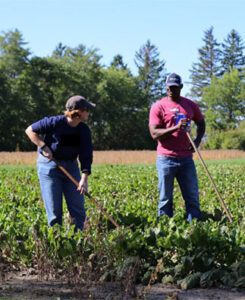 In the summer of 2024, our outreach workers helped 11 groups of migrant agricultural worker (Niagara + Simcoe) record indoor temperatures in their employer provided housing. (Utilizing Aranet4 and SwitchBot Thermo-hydrometers). The Data collected was reviewed and organized for presentation by John Oudyk and Dr. Donald Cole, with John creating a presentation titled, “Report on indoor temperatures in migrant agricultural worker bunkhouses - preliminary findings”.
In the summer of 2024, our outreach workers helped 11 groups of migrant agricultural worker (Niagara + Simcoe) record indoor temperatures in their employer provided housing. (Utilizing Aranet4 and SwitchBot Thermo-hydrometers). The Data collected was reviewed and organized for presentation by John Oudyk and Dr. Donald Cole, with John creating a presentation titled, “Report on indoor temperatures in migrant agricultural worker bunkhouses - preliminary findings”.
This project highlighted methodology, and concern of exposure to heat among workers in their employer provided housing, and the need for regulation/ temp standard. Following a presentation of this data to the ESDC/ Gov of Canada on Dec. 12, 2024, on March 6, 2025, these findings were presented to Mexican Consulate Offices (Ottawa, Toronto, and Leamington offices). Mexico is leading sending country of Ontario migrant agricultural workers. Virtual presentation. The team has connected to UBC project team who conducted similar project: https://climatejustice.ubc.ca/wp-content/uploads/sites/45/2024/08/FINAL-RAMA-Report.pdf
OHCOW will be working with partners to expand this project (more worker houses across more regions) this 2025 summer season.
This infographic is available in four languages. It displays colourfully the issues specific to Temporary Foreign Agricultural Workers. In March, an informative webinar on this and other resources was conducted. Also discussed was how to gain access virtual or print copies of our temporary foreign agricultural worker resources, and opportunities to collaborate on, or host, our workshops for workers in your networks.
